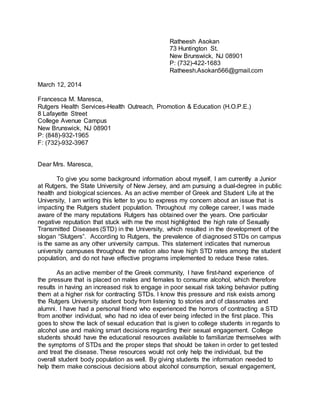The document proposes developing programs to integrate alcohol and sexual education on college campuses and make condoms more accessible. It notes high STD rates among college students which correlate with risky sexual behaviors often associated with alcohol use. The proposal recommends preparing educational programs on the risks of STDs, alcohol, and sexual activity to help students make safer choices to reduce disease transmission.























![Appendix B
Sample Survey:
1. Did you find the alcohol and sexual risk taking behavior presentations informative?
[ ] Yes
[ ] No
[ ] I am not sure
2. Did the program address the increasing STD prevalence rate on college campuses
across the United States?
[ ] Yes
[ ] No
[ ] I am not sure
3. Did the speaker address t while engaging in sexual risk taking behavior while under
the influence students are put at an even greater risk of contracting an STD?
[ ] Yes
[ ] No
[ ] I am not sure
4. Did the program make you aware of the preventive measures(ex. contraceptives/birth
control) and testing facilities/clinics on campus?
[ ] Yes
[ ] No
[ ] I am not sure
5. Are you aware of the free condoms available on all main campus locations(ex.
student centers, libraries, and recreational facilities)?
[ ] Yes
[ ] No
[ ] I am not sure
6. Did you know that members of the Greek community are at higher risk of STD’s, due
to the heavily alcohol consumption atmosphere that is created that leads individuals to
engage in poor sexual risk taking behavior?
[ ] Yes
[ ] No
[ ] I am not sure
What is the overall goal of the program and the taken home message for students?](https://image.slidesharecdn.com/97e61ab8-9822-49f6-a738-b9cd0386ea7f-161216011616/85/Asokan_-Grant-Proposal-doc-24-320.jpg)